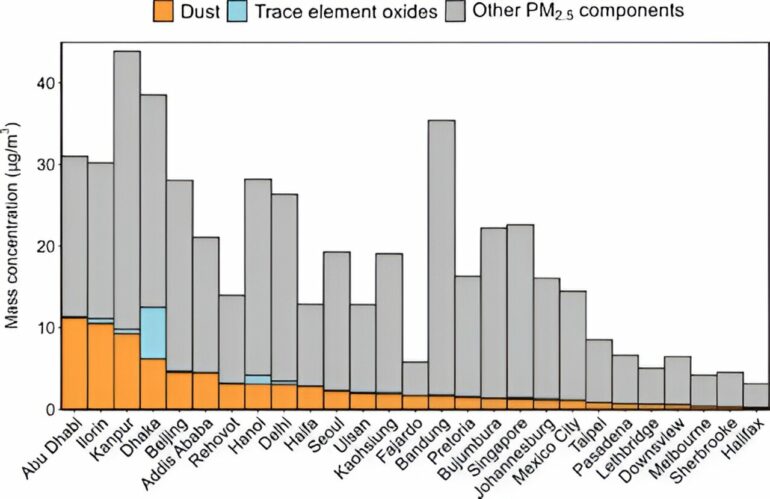As anyone with seasonal allergies knows, unseen airborne particles can really wreck a person’s day. Like the tree pollen that might be plaguing you this spring, small concentrations of trace elements in the air can have significant negative impacts on human health. However, unlike pollen counts and other allergy indices, which are carefully tracked and widely available, limited knowledge exists about the ambient concentrations of cancer-causing trace elements like lead and arsenic in urban areas of developing countries.
A recent effort led by Randall Martin, the Raymond R. Tucker Distinguished Professor in the McKelvey School of Engineering at Washington University in St. Louis, analyzed global ambient particulate matter (PM) to understand two of its key components, mineral dust and trace element oxides. Trace elements—such as lead and arsenic—have well-documented associations with adverse health outcomes. While dust originates from both natural sources like deserts and human activities like construction and agriculture, trace elements are predominantly emitted by human activities like fossil fuel combustion and industrial processes.
Martin’s team, including Jay Turner, the James McKelvey Professor of Engineering Education at WashU, and Xuan Liu, a graduate student working with Martin and Turner in the Department of Energy, Environmental & Chemical Engineering, examined data collected by the Surface PARTiculate mAtter Network (SPARTAN), the only global monitoring network that measures PM elemental composition.
Their work, published in ACS ES&T Air, produced a valuable dataset and methodology to identify regions with elevated trace elements. The findings also highlighted regions of concern in Bangladesh, India and Vietnam, which might benefit from interventions to reduce trace element emission from human activities.
“Reliable elemental composition data of ambient PM is crucial to understand the health risks associated with exposure to airborne trace elements,” said Liu, the first author on the paper. “Our work highlights the significant health risks caused by elevated levels of airborne trace elements, particularly arsenic, in South and Southeast Asia.”
“This work draws attention to the need for sustained consistent monitoring of the elemental composition of fine particulate matter in urban areas worldwide,” Martin added. “Identifying potential emission sources of these elements will inform targeted interventions to mitigate exposure and safeguard public health.”
Though Martin and his collaborators have found in previous studies that global air pollution from fine particulate matter fell between 1998 and 2019 and strategies like replacing traditional fuel sources with sustainable sources of energy could further curb PM pollution, their SPARTAN analysis points to ongoing concerns regarding exposure to trace elements through inhalation of PM. The team identified informal lead-acid battery recycling, e-waste recycling and coal-fired brick kilns as potential contributors to the elevated concentrations of trace elements particularly in Dhaka, Bangladesh.
More broadly, the team noted that concentrations of trace elements are particularly high in low-income and middle-income countries due to unregulated urbanization and industrialization. However, PM monitoring networks in these areas are spotty at best, hindering researchers’ understanding of dust and trace element levels and their emission sources. Uniform sampling methods and reliable analyses are needed to enable comparisons across the world.
“Our growing sample collection will lead to better estimations of dust and trace element concentrations, which will allow us to perform more accurate health risk assessment and thorough investigation into emission sources,” Liu said. “Certain SPARTAN sites have been selected or established as part of the Multi-Angle Imager for Aerosols (MAIA) satellite mission dedicated to studying the health impacts of various types of airborne particles. This collaboration will yield a large dataset with increased sampling frequency, helping us identify pollution sources more effectively in the future.”
More information:
Xuan Liu et al, Elemental Characterization of Ambient Particulate Matter for a Globally Distributed Monitoring Network: Methodology and Implications, ACS ES&T Air (2024). DOI: 10.1021/acsestair.3c00069
Provided by
Washington University in St. Louis
Citation:
Global study reveals health impacts of airborne trace elements (2024, April 17)



